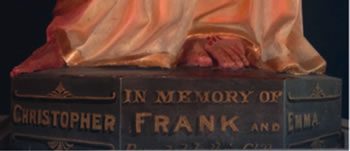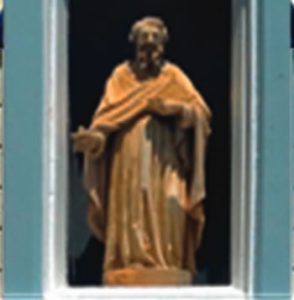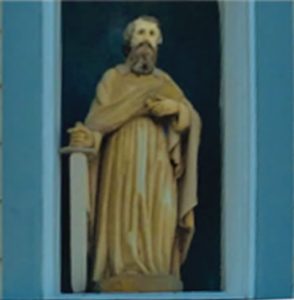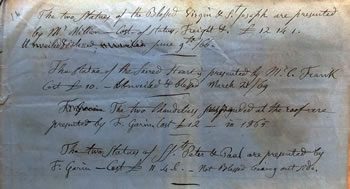Carrying a Sword
I passed through Nelson at the beginning of this year and joined Fr Tony Kearns and congregation at the 8:30am Sunday Mass. As Fr Tony and I waited in front of the church before processing in I noticed a change in the façade – St Paul had a sword!
In the Marist Messenger of March 2015 I wrote:
Two saints occupy the upper register of the façade, between us and the Trinity. They are Peter with his keys and Paul with his book, but now missing his sword. These are not the patron saints of this church but rather those of the church of Rome. In purchasing and placing these two statues Fr Garin, was making a statement about local and universal. This little church in far flung New Zealand belonged to something much bigger.
The ‘attributes’ of a saint are artistic conventions that associate a set of symbols with a certain person so that viewers can identify the saint concerned. It is not a convention unique to Christian art, Greek and Roman gods can also be identified by their attribute – we still put the snake symbol of the god of healing outside pharmacies.
Some attributes are generic – a palm branch for a martyr, a book or scroll for a writer. Other attributes are unique to a single saint – St Peter’s keys for example. There are a lot of saints and only so many symbols so it can get complicated and involve some guesswork and attention to context.
The attribute often refers to how the saint was martyred – the X-shaped cross for St Andrew, the skinning-knife for St Bartholomew, the wheel for St Catherine. The attribute may be a key relationship – Mary’s attribute is the child Jesus, St Anne is usually shown with Mary as a child, and often as teaching her to read
Some attributes relate to the name of the saint – St Agnes is shown with a lamb because her name means ‘lamb,’ St Lucy is shown with a pair of eyes because her name means ‘light.’
Founders of Religious Orders are usually shown in the habit of their congregation and with the book of the Constitutions or Rule or their most famous work. Kings and Queens have crowns. Bishops have their episcopal mitre and crozier – leading to the joke that “you never see a Bishop without seeing a crook.”
St Paul is depicted with a sword because, according to legend, he died by beheading. He wrote many letters which constitute a significant part of the New Testament so he is shown holding a book. The juxtaposition of the sword and book calls to mind a line of his (Heb 4:12) “Indeed, the word of God is living and effective, sharper than any two-edged sword, penetrating even between soul and spirit, joints and marrow, and able to discern reflections and thoughts of the heart.” For this reason the sword that St Paul holds is always a two-edged one!
The statues of St Peter and Paul are older than the venerable church whose façade they adorn. We know this thanks to a document in the Marist Archives in Wellington.
It reads:
The two statues of the Blessed Virgin and St Joseph are presented by Mr Nillion [?] – Cost of Statues, Freight etc £12 14 1.
Unveiled and blessed June 9th /66.
The Statue of the Sacred Heart is presented by Mr. C. Frank
Cost £10. – unveiled and blessed March 21 / 69
The two Chandeliers suspended at the roof are presented by Fr. Garin. Cost £12 – in 1865
The two statues of SS.ts Peter & Paul are presented by Fr Garin – Cost £11.4.6 – Not blessed being outside.
 The inscription on the Sacred Heart statue above the tabernacle in the St Mary’s Church shows that theses statues must have been rescued from the 1881 fire which destroyed the first church which had been built on the site in 1864.
The inscription on the Sacred Heart statue above the tabernacle in the St Mary’s Church shows that theses statues must have been rescued from the 1881 fire which destroyed the first church which had been built on the site in 1864.
St Peter and St Paul have been gazing down upon Nelson parishioners as they file into church for a very long time. Fr Garin would be pleased that his gift is still appreciated.




 Entries(RSS)
Entries(RSS)